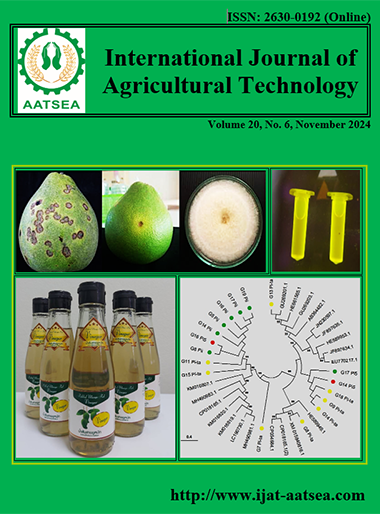Propagation of Phellinus linteus originated from An Giang, Vietnam
Main Article Content
Abstract
A wild mushroom species from the highland regions of An Giang province, Vietnam, was identified as Phellinus linteus AG (commonly known as Sang-Hwang mushroom) through a combination of morphological characteristics and ITS sequence comparison. The ITS sequences, amplified using the primer pair ITS1 (5'-TCCGTAGGTGAACCTGCGG-3') and ITS4 (5'-TCCTCCGCTTATTGATATGC-3'), showed a 92% similarity to those in the GenBank database. The optimal medium for the first propagation phase was potato dextrose agar (PDA), with complete hyphal growth observed after 7 days. For the second propagation phase, paddy was found to be the best medium, also achieving full hyphal growth in 7 days. The most suitable medium for producing a high yield of fruiting bodies consisted of 90% rubber sawdust + 5% rice bran + 5% corn flour. Fruiting bodies developed after 33 days, and were ready for harvest after 55 days, with a biological efficiency of approximately 0.47%.
Article Details

This work is licensed under a Creative Commons Attribution-NonCommercial-NoDerivatives 4.0 International License.
References
Chen, W., Tan, H., Liu, Q., Zheng, X., Zhang, H., Liu, Y. and Xu, L. (2019). A Review: The Bioactivities and Pharmacological Applications of Phellinus linteus. Molecules, 24. Retrieved from doi:10.3390/molecules24101888.
Hsieh, P. W., Wu, J. B. and Wu. Y. C. (2013). Chemistry and biology of Phellinus linteus. BioMedicine, 3:106-113.
Huang, Y., Wu, X., Jian, D., Zhan, Y. and Fan, G. (2015). De novo transcriptome analysis of a medicinal fungi Phellinus linteus and identification of SSR markers. Biotechnology & Biotechnological Equipment, 29:395-403.
Hultberg, M. and Golovko, O. (2024). Use of sawdust for production of ligninolytic enzymes by white-rot fungi and pharmaceutical removal. Bioprocess and Biosystems Engineering, 47:475-482.
Ku, Y. H., Kang, J. H. and Lee, H. (2022). Effects of Phellinus linteus extract on immunity improvement: A CONSORT-randomized, double-blinded, placebo-controlled trial. Medicine, 101.
Khursheed, R., Singh, S. K., Wadhwa, S., Gulati, M. and Awasthi, A. (2020) Therapeutic potential of mushrooms in diabetes mellitus: Role of polysaccharides. International Journal of Biological Macromolecules, 164:1194-1205.
Lee, J. W., Baek, S. J. and Kim, Y. S. (2008). Submerged Culture of Phellinus linteus for Mass Production of Polysaccharides. Mycobiology, 36:178-182.
Liu, Y., Wang, C., Li, J., Li, T., Zhang, Y., Liang, Y. and Mei, Y. (2020). Phellinus linteus polysaccharide extract improves insulin resistance by regulating gut microbiota composition. The FASEB Journal, 34:1065-1078.
Min, G. J. and Kang, H. W. (2021). Artificial Cultivation Characteristics and Bioactive Effects of Novel Tropicoporus linteus (Syn. Phellinus linteus) Strains HN00K9 and HN6036 in Korea. Mycobiology, 49:161-172.
Omarini, A. B., Labuckas, D., Zunino, M. P., Pizzolitto, R., Fernández-Lahore, M., Barrionuevo, D. and Zygadlo, JA. (2019). Upgrading the Nutritional Value of Rice Bran by Solid-State ermentation with Pleurotus sapidus. Fermentation, 5. Retrieved from doi:10.3390/fermentation5020044.
Shin, K. S. (2011). Molecular Identification of Two Strains of Phellinus sp. by Internal Transcribed Spacer Sequence Analysis. Mycobiology, 39:299-300.


